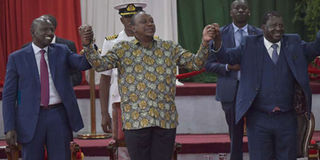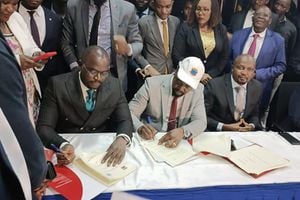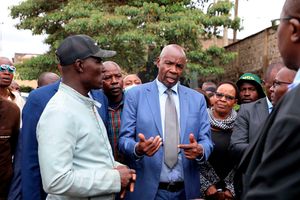BBI addresses critical concerns we can build on

President Uhuru Kenyatta (centre), Deputy President William Ruto) left) and ODM leader Raila Odinga during the launch of the BBI report at Bomas of Kenya in Nairobi on November 27, 2019. PHOTO | FILE | DPPS
What you need to know:
- In 2004, Raila Odinga, Uhuru Kenyatta, William Ruto and Musalia Mudavadi supported the Bomas Draft.
- In the 2007 general election, Raila Odinga, Musalia Mudavadi and William Ruto became political allies.
Is the raison d’etre of the Building Bridges Initiative (BBI) simply the creation of multiple executive positions — president, deputy president, prime minister and two deputy prime ministers — to serve a dynastic oligarchy?
Rephrased, is the BBI likely to promote a broader public interest or a narrow self-serving political agenda?
Will it be the antidote to the perennial ethnically instigated electoral mayhem witnessed almost every electoral cycle?
BBI PROPOSALS
Are the BBI proposals likely to supplement the 2010 constitution so as to strengthen Kenya’s governance and socio-economic system?
The push for fragmentation of Kenya’s executive started during the constitutional debate of the 80s leading to the Bomas conference. Both civil society activists and political opposition agitated for taming of the imperial presidency.
The proposed Article 151 of the Draft (Bomas) Constitution of 2004 provided for the offices of president, deputy president, prime minister and more than one deputy prime ministers.
In 2004, Raila Odinga, Uhuru Kenyatta, William Ruto and Musalia Mudavadi supported the Bomas Draft.
However, the Narc – ODM-K – Ford People and a section of Kanu coalition advocated for the Wako Draft, which maintained only the president and deputy president positions. The pro-Bomas group successfully defeated President Mwai Kibaki’s Wako or Kilifi Draft; hence the emergence of the Orange Democratic Movement (ODM).
GENERAL ELECTION
In the 2007 general election, Raila Odinga, Musalia Mudavadi and William Ruto became political allies. After the 2007/8 electoral conflict, Kofi Annan and others led a rapprochement between the feuding political adversaries, which birthed the Constitution of Kenya (Amendment) Act, 2008. Section 3 of this Act amended the independence constitution to introduce Section 15A.
This new section created the positions of the prime minister and two deputy prime ministers. Mwai Kibaki remained president, Stephen Kalonzo Musyoka vice-president, Raila Odinga prime minister, Uhuru Kenyatta deputy prime minister and Musalia Mudavadi deputy prime minister. William Ruto served as a Cabinet minister on Odinga’s side of the coalition.
The Bomas and the 2008 constitutional changes clearly fronted for a multiple executive. Therefore, the current top leadership has at one time or the other supported the diffusion of executive power through the creation of more than two key offices.
In 2008, all these top leaders were unanimous in championing for the offices of the president, vice president, prime minister and two deputy prime ministers.
EXECUTIVE MODEL
Therefore, simply put, the BBI does not seek to re-invent the wheel. Its current executive model is akin to both the 2008 Grand Coalition model and the current Tanzanian model (Arts 51-52).
The Bomas draft executive model was akin to that in our 1963 constitution and the French Constitution.
The argument for the proposed multiple executive is that it provides for political accommodation of Kenya’s ethnic communities.
There is an inherent admission that we continue to be ethnically divided. We are yet to become a nation-state.
Arguably Kenya’s 45 ethnic groups (including sub-tribes) can be housed within the top five offices, the two Speakers of Parliament, the attorney general, the 20 or so Cabinet ministers, the same number of ministers of state (assistant ministers) and more than 20 permanent secretaries.
The argument is each ethnic community as well as other social communities such as gender, youth, PWD and other marginalised groups will sit at the government’s decision-making table.
PRIME MINISTER
The winner-takes-it-all mentality generated by the first-past-the-post elections will become history.
Interestingly, in Tanzania, where Chama Cha Mapinduzi (CCM) is founded on ideology, there is still a compound executive with a prime minister. Due to their relative political cohesion, accommodation on the basis of tribe is not a norm; a priority. Often in Tanzania, presidents have emerged from minor ethnic groups. Julius K. Nyerere was one such example.
Given the way Kenya is currently organised, it would be a major feat for a Bajuni, Burji, Dahalo, Dasenach, Dorobo, Gosha, Konso, Makonde, Nubi and so on to become the president or deputy president as per the current constitution. Even finding space in Cabinet or key public positions is largely a pipe dream.
If the BBI proposals are to socialise and expand the executive, they must explicitly provide that all ethnic communities (e.g. in Ethiopia) and social communities must be considered, including within parliament through proportional representation. There are communities who are clear minorities in each of the 290 constituencies.
In an ethnically based electoral system, they would not get representation through competitive parliamentary and even county assembly elections.
CONSTITUTIONAL CHANGE
Other areas of constitutional change that should be addressed relate to the following: reform of the Independent Electoral Boundaries Commission and entire electoral system so as to ensure democratic, free and fair elections; creation of a strong opposition with a shadow cabinet; securing gender representation in Parliament and other public bodies; constitutional entrenchment of the EACC to guarantee its independence and claws; reserving a floor of between 35 per cent and 45 per cent national taxes to the devolved units; amending articles 91 and 92 of the Constitution to ensure political parties become true engines of democracy and structured coalition-building; strict adherence to Schedule 4 on the division of national and county functions and fidelity to the rule that “money follows functions”; constitutional budgetary provision for the judiciary; safeguarding the ward as the fulcrum of development and the independence of county assemblies; rationalising the wage bill; zealously protecting public and community land; amending Article 55 on youth to guarantee real opportunities for young people by, among other things, allocating a minimum of 5 per cent of the devolved funds (on top of other national government revenue) to male and female youths under their independent Authority run by them.
In my view, the BBI addresses critical concerns that Kenyans can build upon.
However, we have to overcome the fear that a combination of the big five ethnic communities could dominate the executive ad infinitum. We have to depoliticise the BBI process to guarantee a truly inclusive and progressive leadership.
The writer is governor of Makueni County





